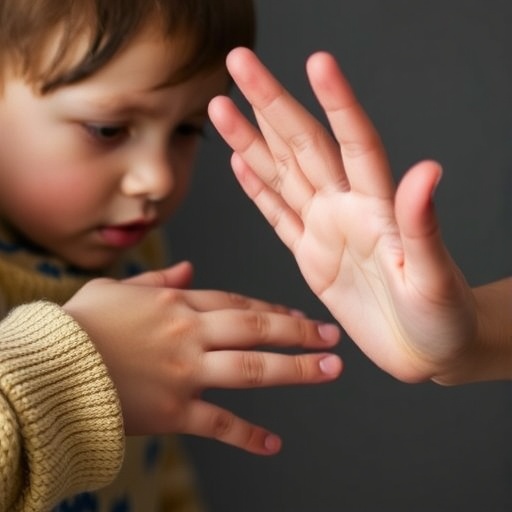The intricate relationship between touch and social interaction has garnered significant focus in recent years, particularly in the context of autism spectrum disorders (ASD). A groundbreaking study led by Mello et al. in 2025 presents a compelling exploration of how touch avoidance centralizes experiences of social touch for individuals on the autism spectrum. This research has far-reaching implications, not only for understanding the sensory processing differences inherent in ASD but also for informing therapeutic approaches that could enhance social engagement among affected individuals.
The central thesis of the study posits that for many individuals with autism, touch avoidance is not merely a preference but a profound reflection of their sensory and emotional experiences. The researchers conducted a series of carefully designed experiments aimed at unraveling the complexities of touch transference in social contexts for those with autism. Through a combination of qualitative assessments and quantitative measures, the study sheds light on the nuanced ways in which social touch is experienced and often rejected by individuals with ASD.
Delving deeper into the research methodology, the team employed a mixed-methods approach that integrated psychological assessments and neurophysiological measurements. Participants, comprising a varied cohort of individuals diagnosed with autism, were subjected to a battery of tests designed to evaluate their responses to touch stimuli in various social scenarios. These included both direct touch interactions and indirect exposure to touch cues, such as observing others being touched. The data revealed startling trends, highlighting a significant correlation between heightened touch avoidance and increased social anxiety.
Furthermore, the researchers identified distinct patterns in touch interaction preferences, which diverged notably from neurotypical populations. Participants with autism often expressed discomfort regarding social touch but exhibited varied responses depending on the context and the nature of the interaction. While some individuals demonstrated an aversion to touch entirely, others indicated a preference for specific types of touch or certain individuals. This variability underscored the need for personalized approaches in therapeutic settings, allowing caregivers and practitioners to tailor strategies to meet individual sensory needs.
In analyzing the emotional responses tied to touch, the study revealed that individuals with ASD often experience a heightened state of sensory overload in environments that involve social touch. This overload can manifest in various ways, including increased agitation, withdrawal, or an outright refusal to engage in social interactions. The findings suggest that understanding these reactions is crucial for developing supportive environments that can help ease the discomfort associated with social touch.
The implications of this research extend beyond theory, as it lays the groundwork for practical applications in daily life. Sensory-friendly environments, adjustments in educational settings, and caregiver training programs can all benefit from insights gained through this study. By fostering environments that respect individual sensory thresholds, it may be possible to alleviate some of the anxieties tied to social touch and improve overall quality of life for individuals with autism.
Moreover, the study emphasizes the importance of respecting individual autonomy in social interactions. For many individuals with autism, the ability to decide when and how they wish to engage with others can greatly influence their willingness to participate in social touch experiences. Creating situations where individuals can express boundaries not only enhances their comfort levels but also promotes healthier social relationships.
The research also calls attention to the broader societal perceptions of autism and touch. Misunderstandings often arise regarding individuals who reject social touch, with assumptions made about their emotional states or social skills. By clarifying the underlying sensory reasons for touch avoidance, this study aims to foster a greater understanding and empathy within society at large, promoting acceptance and support for those with autism.
As the field continues to explore the depths of sensory processing in autism, studies like this one play an essential role in reshaping discourse around touch and social interaction. The conversation surrounding autism has increasingly highlighted the need for inclusive practices that accommodate neurodiversity, and the findings of Mello et al. serve as a pivotal contribution to this dialogue.
In summary, the centrality of touch avoidance in social touch experiences among individuals with autism presents a rich area for exploration. The comprehensive nature of this research not only reveals the intricacies of sensory experiences but also offers valuable insights that can lead to more effective interventions. By bridging the gap between sensory processing and social interaction, we can better understand and support the diverse experiences of those on the autism spectrum.
The future of research in this domain is bright, with many opportunities for further investigation. Future studies could expand on these findings by delving into how age, gender, and cultural contexts impact touch experiences and preferences. Additionally, longitudinal studies that track changes in touch avoidance over time could provide deeper insights into the developmental trajectories of touch-related behaviors in autism.
In closing, Mello et al.’s extensive research underscores the pivotal role of touch in social experiences and the profound impact of touch avoidance within the autism spectrum. Understanding these dynamics is not just an academic endeavor; it directly influences the lives of individuals with autism, helping to create a more inclusive and understanding society that values the diverse sensory experiences of all its members.
Subject of Research:
The centrality of touch avoidance in social touch experiences in autism.
Article Title:
Centrality of Touch Avoidance in Social Touch Experiences in Autism.
Article References:
Mello, M., Fusaro, M., Aglioti, S.M. et al. Centrality of Touch Avoidance in Social Touch Experiences in Autism.
J Autism Dev Disord (2025). https://doi.org/10.1007/s10803-025-07053-x
Image Credits:
AI Generated
DOI:
Keywords:
Touch, Autism, Sensory Processing, Social Interaction, Touch Avoidance, Neurodiversity, Social Anxiety, Caregiver Strategies, Emotional Responses, Inclusive Practices.
Tags: autism spectrum disorder research findingscomplexities of touch transferenceemotional experiences of individuals with autismMello et al. 2025 studymixed-methods research in autismneurophysiological measurements in autism researchqualitative and quantitative research in autismsensory processing differences in ASDsocial engagement strategies for ASDsocial touch experiences in autismtherapeutic approaches for autismtouch avoidance in autism





